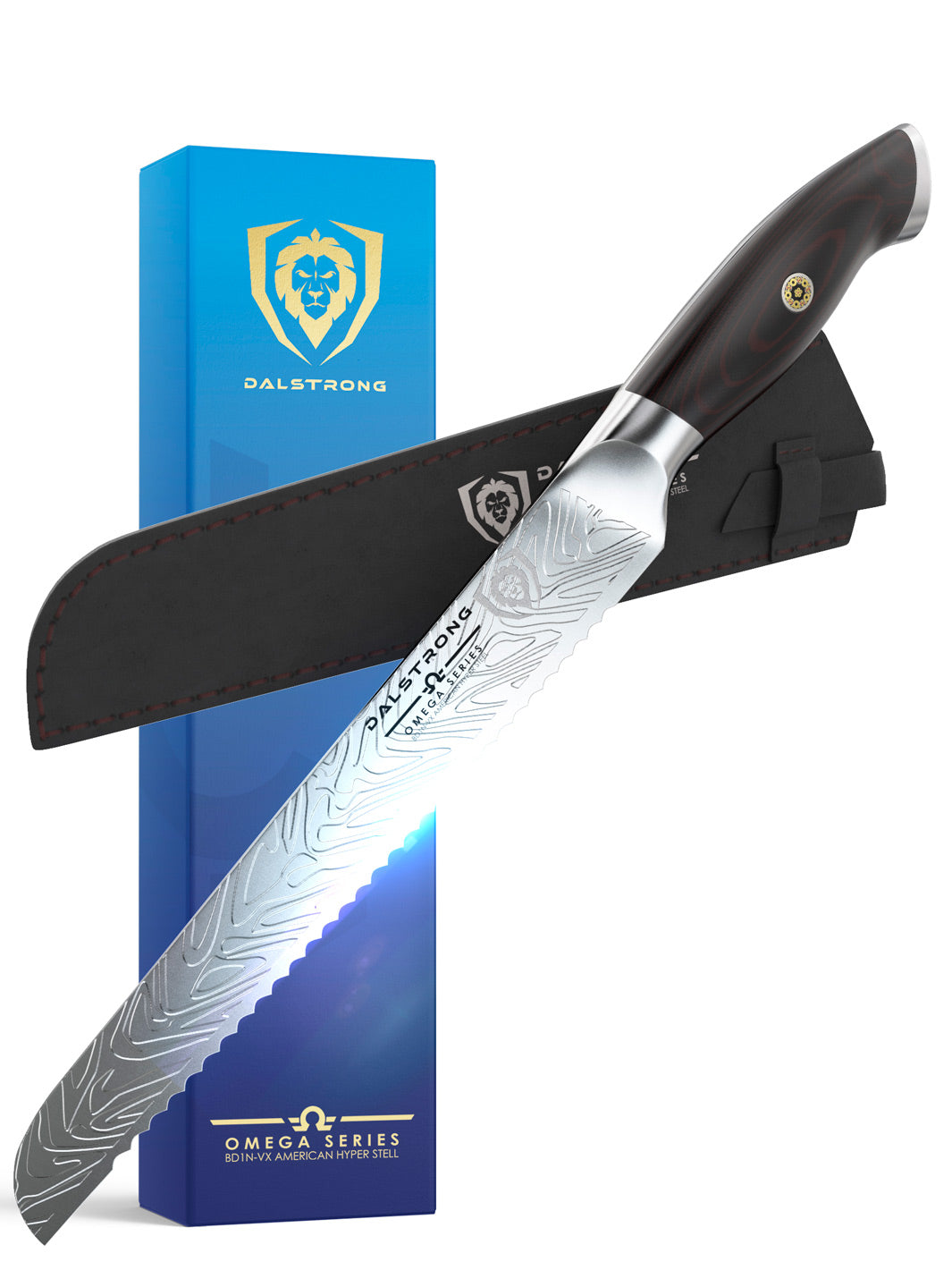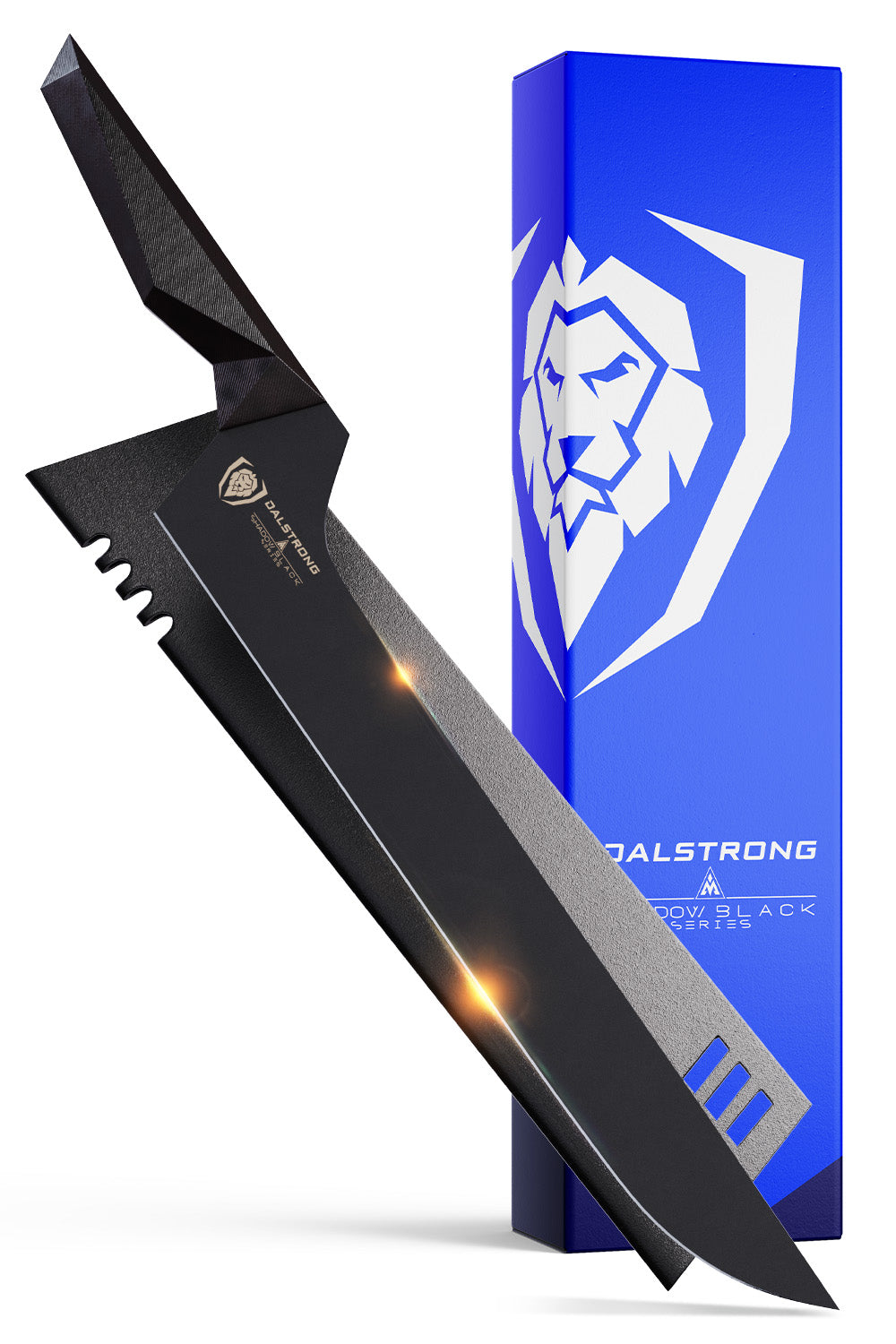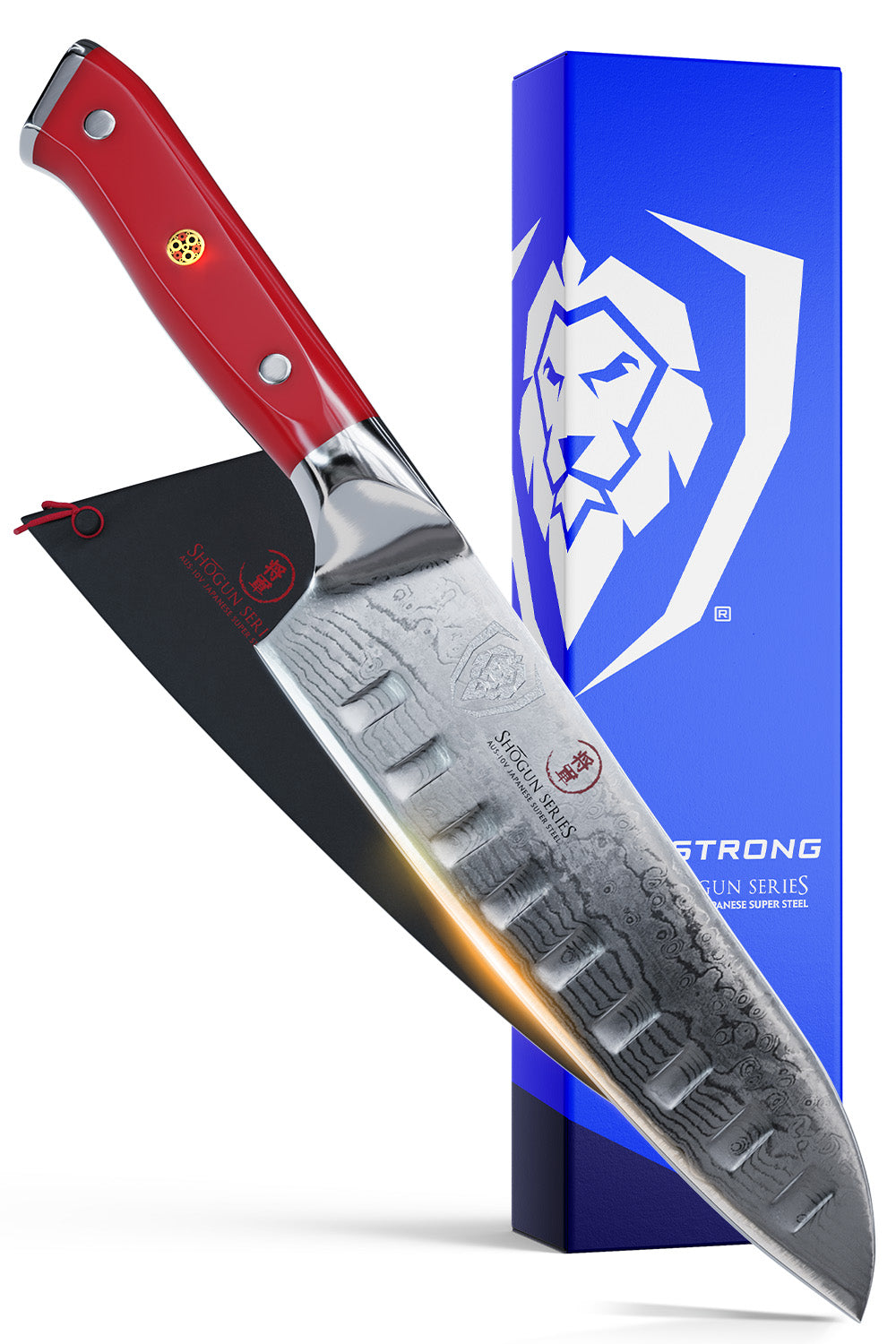 Kiritsuke Chef's Knife 8.5" Collector Set Omega Series Dalstrong
Kiritsuke Chef's Knife 8.5" Collector Set Omega Series Dalstrong
In the bustling symphony of the kitchen, where creativity dances with flavors and aromas, there emerges a silent yet indispensable maestro, the cooking knife.
This elegant instrument of precision weaves its way through the culinary landscape, transforming raw ingredients into culinary masterpieces with every artful stroke. Its razor-sharp edge effortlessly glides through vegetables, fruits, and meats, breathing life into the chef's vision and unlocking the secrets hidden within each dish.
Like a trusted companion, the cooking knife becomes an extension of the chef's hand, bridging the gap between imagination and reality, and turning ordinary ingredients into extraordinary experiences.
Let us delve into the mesmerizing world of the cooking knife, where every cut tells a story, and the pursuit of culinary excellence is carved one slice at a time.
1. What Is A Cooking Knife
 Chef's Knife 8.5" Quantum 1 Series Dalstrong
Chef's Knife 8.5" Quantum 1 Series Dalstrong
A cooking knife is a flexible kitchen tool crafted for several food preparation tasks, such as slicing, chopping, dicing, and mincing ingredients. Also known as a cook's knife or a chef's knife, it is an required part of any home cooks arsenal. A well-made cooking knife is identified by a sharp, sturdy blade and a comfortable to hold handle that allows for effortless and accurate cutting.
The typical features of a cooking knife include:
Blade
The blade is usually made from high-carbon stainless steel, which ensures excellent cutting performance and resistance to corrosion. It should have a sharp edge that retains its sharpness for an extended period, and it tapers to a point, allowing for precise work.
Length
Cooking kitchen knives come in various lengths, typically ranging from 15 to 30 cm (6 to 12 inches). The most usual size is around 8 inches (20 cm), as it gives a good balance between cutting capacity and maneuverability.
Spine and Bolster
The spine of the blade is the top, non-cutting edge, while the bolster is the thickened junction between the blade and the handle. The bolster adds balance and weight to the knife and helps protect your fingers during cutting.
Handle
Handles are typically made of various materials, such as plastic, wood, or composite materials. A good handle should give a comfortable grip and be easy to hold during extended periods of use.
Tang
The tang is the addition of the blade into the handle. A full tang knife has the blade extending the full length of the handle, providing better balance and durability compared to partial tang knives.
Weight and Balance
The perfect cooking knife should have a well-balanced weight distribution between the blade and the handle. This balance secures better control and reduces fatigue during prolonged use.
Maintenance
Cooking kitchen knives needs regular maintenance, including honing with a honing rod to maintain the edge and occasional sharpening to bring back its sharpness.
Remember, a good cooking knife can significantly increase your kitchen experience and make food preparation more efficient and enjoyable.
2. Types Of Cooking Knife
There are many types of cooking kitchen knives, each crafted for certain tasks in the kitchen. Having a selection of different kitchen knives can make food preparation more efficient and enjoyable. Here are some usual types of cooking kitchen knives:
Chef's Knife
This all-purpose knife has a broad, sharp blade and is the workhorse of the kitchen. It is ideal for chopping, slicing, dicing, and mincing a wide range of ingredients, including fruits, vegetables, and herbs.
Paring Knife
A small, flexible knife with a short blade, usually around 3 to 4 inches (7.5 to 10 cm) long. Paring knives are ideal for intricate tasks like trimming, peeling, and coring fruits and vegetables.
Santoku Knife
Originating from Japan, the Santoku knife has a shorter, wider blade than a traditional chef's knife. It is excellent for dicing, slicing, and chopping, especially when dealing with fish and vegetables.
Bread Knife
A serrated knife with a long blade, typically around 20 to 25 cm (8 to 10 inches) long. It is designed to cut through bread and other baked goods without compressing or squashing them.
Utility Knife
A smaller version of the 8inch chefs knife, usually around 10 to 15 cm (4 to 6 inches) long. It is suitable for tasks that needs more precision but don't warrant the use of a larger knife.
Boning Knife
This knife has a small, workable curved blade that is perfect for removing bones from meat, fish, and poultry. The blade allows for accurate cuts along bones and joints.
Fillet Knife
Comparable to a boning knife, but with a more flexible and tapered curved blade, ideal for filleting fish.
Cleaver
A heavy, thick-bladed knife used first for chopping through bones and thick cuts of meat. It can also be used for squash garlic and other tough tasks.
Nakiri Knife
A Japanese knife with a straight, thin blade crafted specifically for slicing and dicing vegetables.
Slicing Knife
A long, tapered knife with a smooth edge, used for accurately slicing cooked roasts, meats, and poultry.
Tomato Knife
A small serrated knife crafted specifically for slicing tomatoes and other delicate vegetables and fruits with ease.
Mezzaluna
Not a traditional knife, but a curved blade with two handles on either end, used for efficiently chopping nuts, herbs, and other small ingredients by rocking it back and forth.
Having a well-rounded set of cooking kitchen knives can cover a wide range of kitchen duties, but it's vital to pick knives based on your cooking liking and the type of ingredients you commonly work with. Always remember to keep your knives (either Japanese knives or Western knives) well-maintained and sharp for ideal performance and safety in the kitchen.
3. Top Qualities Of A Good Cooking Knife
8inch Chefs Knife Valhalla Series Dalstrong
A good cooking knife should have several vital qualities that give to its performance, functionality, and overall usability in the kitchen. Here are the top caliber of a good cooking knife:
Sharpness
A high-quality cooking knife should have a sharp blade that can sustain its edge for an extended period. A sharp knife secures effortless and precise cutting, reducing the risk of slippage and accidents.
Blade Material
The blade should be made from high-quality materials, such as high-carbon stainless steel. This combination offers superb cutting durability, cutting performance, and resistance to corrosion and staining.
Blade Shape and Design
The blade should be crafted to facilitate several cutting techniques, such as slicing, chopping, mincing, and dicing. A versatile blade shape, like that of a chef's knife, allows for a wide range of kitchen tasks.
Comfortable Handle
The handle should be fitting designed and comfortable to hold. It should give a secure grip, lessen hand fatigue during prolonged use.
Balance: A well-balanced knife ensures better maneuverability and control during cutting. The weight distribution between the blade and the handle should be harmonious.
Full Tang Construction
A good cooking knife frequently features a full tang, where the blade extends the full length of the handle. Full tang construction adds durability and stability to the knife.
Easy Maintenance
A good cooking knife should be effortless to maintain. It should be able of being sharpened easily to keep its sharpness and edge over time.
Durability
The knife should be qualified and sturdy of withstanding the difficulty of daily use in the kitchen. High-quality materials and construction provide to the knife's overall durability.
Versatility
A flexible cooking knife can handle a wide range of tasks, lessen the need for multiple specialized Japanese knives. A chef's knife, for example, can perform several cutting techniques.
Safety Features
The knife should have safety features like a bolster to protect fingers during cutting and a well-designed handle to prevent slipping.
Size
The size of the knife should match your hand size and the type of cutting tasks you frequently undertake. A knife that feels comfortable to hold in your hand is more likely to be used safely and efficiently.
Reputation and Brand
Opting for reputable brands and well-known knife manufacturers can provide assurance of quality and performance. Trusted brands like Dalstrong often use high-grade materials and adhere to strict manufacturing standards.
Remember that a good cooking knife is an investment that, with proper care and maintenance, can last for many years, making food preparation more enjoyable and efficient in the kitchen. Always prioritize safety, and choose a knife that suits your cooking style and needs.
4. Must-Have Dalstrong Cooking knives
1. Chef's Knife 8" Shogun Series ELITE Dalstrong
The 8-inch Chef's Knife from Shogun Series ELITE by Dalstrong is a culinary powerhouse, meticulously crafted to elevate your cooking experience to new heights. With a perfect balance of form and function, this knife embodies the harmony of traditional craftsmanship and cutting-edge technology, making it a top pick for both passionate home cooks and professional chefs.
PROS:
- The ultra-sharp edge, painstakingly hand-finished to 8-12 degrees per side, delivers exceptional cutting performance.
- The blade is precision-forged from a single piece of high-carbon ThyssenKrupp German stainless steel, ensuring remarkable strength, durability, and resistance to stains and corrosion.
- The knife boasts a stunning Damascus pattern on the blade, adding a touch of elegance to your kitchen arsenal.
CONS:
- As a premium-quality knife, the Shogun Series ELITE comes with a higher price tag.
- If you’re used to slicing herbs using a rocking movement, you may take a minute to get used to this specific knife, but once you’ve got a hang of it, you’ll be great.
2. Kiritsuke Chef's Knife 9.5" Phantom Series Dalstrong
The Kiritsuke Chef's Knife 9.5" from the Phantom Series by Dalstrong is inspired by the revered Kiritsuke design. This knife embodies the soul of ancient blade-making techniques, harmonizing tradition with modern innovation to create a culinary masterpiece.
PROS:
- The Kiritsuke blade combines the features of a chef's knife and a traditional japanese knives, offering exceptional versatility.
- The beautifully crafted blade showcases an exquisite tsuchime finish, creating a mesmerizing rippled pattern that reduces drag and prevents food from sticking, elevating both aesthetics and performance.
- The ergonomic G10 handle, triple-riveted for extra durability, offers a comfortable and secure grip, allowing for effortless control during prolonged use.
CONS:
- The Kiritsuke blade shape might not be familiar to all users.
- Mastering its unique design may require some time and practice.
3. Dalstrong Fillet Knife 6" Shadow Black Series NSF Certified
The 6" Fillet Knife from the Shadow Black Series by Dalstrong is essential. This sleek, all-black blade stands ready to deliver exceptional filleting performance while adding an edgy and bold statement to your kitchen.
PROS:
- The 6-inch curved blade boasts just the right amount of flexibility, allowing for seamless filleting of fish, poultry, and other delicate meats.
- Corrosion resistance for long-lasting performance.
- The knife carries the NSF certification, ensuring the highest safety and sanitation standards, making it ideal for professional kitchens.
CONS:
- As a fillet knife, its purpose is mainly limited to filleting and deboning tasks, making it less versatile for general kitchen use.
- Its avant-garde design might not be to everyone’s liking.
4. Dalstrong Bread Knife 8" Frost Fire Series NSF Certified
Introducing the Bread Knife 8" from the Frost Fire Series by Dalstrong. A masterful blade designed to conquer crusty loaves and delicate pastries alike, while adding a touch of icy elegance to your kitchen.
PROS:
- The razor-sharp serrated edge slices through bread with ease, delivering clean and precise cuts without crushing or tearing delicate interiors.
- Crafted from high-carbon German ThyssenKrupp stainless steel, the blade is nitrogen-infused for enhanced hardness, durability, and resistance to corrosion.
- The Frost Fire Series features a beautifully crafted G10 handle, providing a comfortable to hold and secure grip, while the smooth design adds a touch of icy allure.
CONS:
- The serrated edge design limits its versatility for tasks beyond slicing bread and soft foods.
- Its blade is a little bit shorter than other Dalstrong bread knives.
5. Dalstrong Paring Knife 3.5" Centurion Series
The Paring Knife 3.5" from the Centurion Series by Dalstrong is also another must-have. This mighty blade, infused with ancient strength and modern precision, is designed to conquer intricate tasks with finesse and grace.
PROS:
- The 3.5-inch blade provides precise control for delicate tasks like peeling, trimming, and intricate garnishing, making it an essential tool for any kitchen.
- The meticulously crafted handle, featuring an ergonomic design, ensures a comfortable to hold and secure grip for effortless maneuverability.
- The Centurion Series showcases an impressive Damascus pattern on the blade, enhancing its visual appeal and making it a striking addition to any kitchen.
CONS:
- The 3.5-inch blade might not be suitable for larger cutting tasks, and users may require an additional, larger knife for more extensive food preparation.
- Some folks prefer utility knives instead of paring knives.
5. Frequently Added Questions
What is the use of knife in cooking?
Knives play a crucial role in cooking, as they are essential tools that aid in various food preparation tasks.
What is the classification of knife?
Knives can be classified based on various factors, including their purpose, blade shape, size, and design.
Is knife a cooking tool?
Yes, a knife is a fundamental and essential cooking tool used in virtually every kitchen around the world. It is one of the most versatile and valuable tools for food preparation.
SHOP DALSTRONG KNIVES TODAY!
















